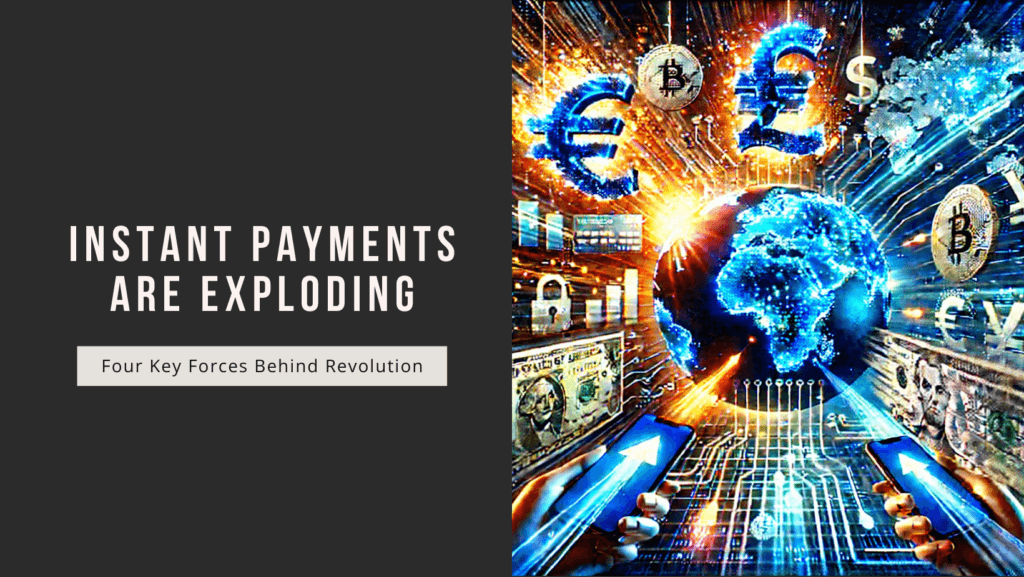Imagine sending money to a friend and watching it land in their account before you’ve even set down your phone. A decade ago, this would’ve felt like sci-fi. Today, it’s the norm for billions of people worldwide. Instant payments systems—think India’s UPI, the EU’s SEPA Instant, NPPS UAE, or the U.S.’s FedNow—are processing trillions of dollars annually, reshaping how we live, work, and transact.
But why now? What’s driving this seismic shift from “wait 3-5 business days” to “money moves at the speed of a text”?
The answer lies in four tectonic forces colliding: evolving consumer expectations, post-pandemic digital transformation, aggressive regulatory reforms, and fintech’s relentless innovation. Let’s unpack how each is fueling the instant payments boom—and what it means for businesses and consumers alike.
Table of Contents
1. Consumer Demand: The “Amazon-ification” of Finance
“Why can’t money move as fast as my Netflix stream?”
That’s the unspoken question driving millennials and Gen Z—generations raised on instant gratification. They’ve grown up with same-day delivery, TikTok-sized content, and apps that solve problems in seconds. Waiting days for paychecks to clear or invoices to settle feels archaic, even disrespectful.

Key stats tell the story:
- 73% of consumers globally expect real-time payments, with Gen Z willing to switch banks for instant capabilities (Visa, 2023).
- 68% of SMEs now demand instant B2B payments to manage cash flow (PYMNTS).
But it’s not just speed—it’s experience.
Instant payments are becoming embedded in everyday life:
- Split-second gig payouts: Uber drivers cash out earnings mid-shift.
- Social commerce: Instagram shoppers pay creators in one click.
- Crisis response: NGOs send disaster aid directly to victims’ phones.
The takeaway? Instant payments aren’t a luxury—they’re table stakes for customer loyalty.
2. Digital Transformation: COVID-19’s Lasting Legacy
The pandemic didn’t just accelerate digital adoption—it forced a survival-level shift.
When lockdowns hit, cash became a liability. Businesses that couldn’t accept digital payments folded. Overnight, street vendors in Mumbai started using QR codes, while U.S. restaurants adopted Venmo for contactless tipping.
The result? A permanent rewiring of habits:
- Global cash usage dropped by 42% between 2019-2023 (FIS Global Payments Report).
- India’s UPI saw a 1,200% surge in transactions during COVID peaks (NPCI).
But the real story is under the hood.
Legacy banks and payment giants, once resistant to change, began racing to modernize. Cloud infrastructure replaced clunky mainframes. APIs turned financial services into plug-and-play tools. Suddenly, a farmer in Kenya could receive payment for crops via mobile money before the buyer left the market.
The lesson? Crisis breeds innovation—and once consumers taste frictionless money, there’s no going back.
3. Regulatory Push: Governments as Catalysts
From New Delhi to Brussels, policymakers are declaring war on payment friction.
Why? Because instant payments aren’t just convenient—they’re economic rocket fuel.
Consider:
- India’s UPI system added $45B+ to GDP by formalizing informal economy transactions (IMF).
- Brazil’s Pix instant system saved businesses $1.3B annually in banking fees (BCB).
Do check the above numbers as of the date you are reading article. They are subjective to change.
Governments are driving adoption through:
- Mandates: The EU’s PSD2 regulation forced banks to open APIs.
- Subsidies: Thailand waived fees for PromptPay transfers under $1,500.
- Public-private partnerships: Singapore’s PayNow merged 17 banks into one network.
But there’s a darker edge.
Regulators also see instant payments as a tool for surveillance. China’s digital yuan, for example, allows unprecedented transaction tracking. This duality—convenience vs. control—will spark fierce debates as adoption grows.
4. Fintech Innovation: Breaking Banks’ Monopoly
Fintechs aren’t just disrupting finance—they’re rebuilding it from the ground up.
How? By solving the “last-mile problem” in instant payments:
- APIs: Companies like Plaid and Stripe turn banks into dumb pipes, letting apps move money seamlessly.
- Blockchain: Ripple’s XRP settles cross-border payments in 3 seconds (vs. SWIFT’s 2-5 days).
- AI Fraud Detection: Feedzai uses machine learning to spot scams in real time.
The impact? A democratization of financial power:
- Nigerian startups like Flutterwave let SMEs accept instant global payments.
- Apps like Venmo and Revolut turned Gen Z into “payment hackers,” splitting bills and investing in crypto mid-transaction.
But the biggest innovation? Microtransactions.
Instant systems make it feasible to charge $0.01 per article read or $0.10 per IoT sensor ping—unlocking entirely new business models.
The Road Ahead: Speed Isn’t Enough
As instant payments become ubiquitous, winners will differentiate through:
- Trust: Battling AI-driven deepfake scams.
- Interoperability: Linking FedNow with India’s UPI and Kenya’s M-Pesa.
- Sustainability: Bitcoin’s energy gluttony vs. eco-friendly alternatives like Solana.
One thing’s certain: Money will keep getting faster. The question is, how will we harness this speed responsibly?
Key Takeaways:
- Consumers now view instant payments as a right, not a privilege.
- COVID-19 permanently shattered our tolerance for financial friction.
- Governments are using instant systems to boost GDP—and control.
- Fintechs are turning money into a feature, not a product.
What’s Next?
👉 Follow me for Part 3 in this series. Will be going more technical explaining the message involved in detail.
Do comment: Would you pay a fee for instant payments?
✅ Yes—speed is worth it.
❌ No—it should be free.